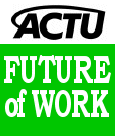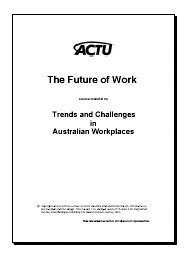No.188 7 July 2003
 BACK
BACK
|

|
— less money, longer hours and harder work
THE FUTURE OF WORK has arrived, and it is not quite what everyone had been hoping for. A major report has been released by the Australian Council of Trade Unions (ACTU) which shows that, after two decades of labour market reform, most Australians are working longer hours, don't get paid for their overtime, and suffer stress at work.
The Future of Work in Australia, written by a Sydney University research unit, shows that much of the Australian workforce is underemployed or has no job security. Nearly half of the workforce is in part-time or casual work, even though most of those in casual work have been doing the same job for over a year. The report predicts that by 2010, one in three workers will be employed on a casual basis.
The report also shows that income inequality in Australia has widened. Almost nine out of every ten of the net new jobs created in the 1990s paid less than $A26,000 a year. Nearly half paid less than $A15,600 a year.
 Greg Combet, Secretary of the ACTU, says that the concern about these questions is not just about
the immediate experiences of those currently in the workforce. Combet: "It is also a concern about
the types of jobs, workplaces and opportunities that will be there for future generations of Australians..."
Greg Combet, Secretary of the ACTU, says that the concern about these questions is not just about
the immediate experiences of those currently in the workforce. Combet: "It is also a concern about
the types of jobs, workplaces and opportunities that will be there for future generations of Australians..."
In the brave new world of "increased flexibility in the labour market", the ACTU points out that it is those with limited or no bargaining power that have increasingly fewer choices over their working lifestyles. Combet: "The distinguishing feature of labour market change is that key players, primarily employers, institutional shareholders and government, are retreating from taking responsibility for work related issues. This is resulting in many of the risks and costs associated with employment falling on the weakest party in a work situation.
• Some of the trends highlighted in the Future of Work in Australia report show: — wage inequality has grown _ only the top 40% of income earners had any real wage growth throughout the 1990s — little more than half of the workforce is now employed on a permanent basis — the net increase in jobs in the 1990s consisted almost entirely of casual and part-time jobs — half of all employees work overtime and 60% of those are not paid for it — the standard model of work has disappeared - only 7% of employees work 9 to 5 — the jobs with the largest number of employees in 2001 were sales assistants, secretaries and cleaners … middle income jobs declined — one million people are casual workers (on term contracts who receive their annual leave pay as a "loading" on their weekly wage and do not have other legal entitlements like sick pay or bereavement leave) — half of casual workers, who are mostly female, have been in the same job for over a year — 51% of employees who work more than 45 hours a week would prefer fewer hours —workers compensation claims for stress have risen from 5% to 19% of all claims in 6 years — 55% of large workplaces (500 or more employees) use labour hire companies
|
• Commenting on the report, Mike Steketee, the national affairs editor of The Australian, says that Australia is at the forefront of workplace revolution. He says that the last giant step in the transformation of the economy — creating a more supple work force to better meet the demands of an internationally competitive economy — has worked a treat for business with increased productivity making labour more efficient and bringing costs down. Steketee: "With only the US among developed countries having comparably high rates of casual work, labour is now sliced up much like any other business inputs into just the right sized pieces to meet the demand for the end product."
 Australian Employment Minister Tony Abbott also agrees that labour market deregulation has played
"a significant part" in creating new jobs, lifting real wages and reducing industrial disputes. Abbott
argues that casual workers, particularly women, prefer casual to permanent employment. He argues the
government balances the earnings gaps through a progressive tax system and government payments. But,
in a burst of frankness, Abbott adds: "The other thing we have to face up to is that in the end we have
to be a productive and competitive society and greater inequality might be inevitable."
Australian Employment Minister Tony Abbott also agrees that labour market deregulation has played
"a significant part" in creating new jobs, lifting real wages and reducing industrial disputes. Abbott
argues that casual workers, particularly women, prefer casual to permanent employment. He argues the
government balances the earnings gaps through a progressive tax system and government payments. But,
in a burst of frankness, Abbott adds: "The other thing we have to face up to is that in the end we have
to be a productive and competitive society and greater inequality might be inevitable."
Business Council of Australia chief executive Katie Lahey thinks that business has learned some really hard lessons since the early 1990s when people were downsizing very quickly and casualising the workforce was their only answer to getting more flexibility in the workforce. Lahey: "We have a few more tricks in our bag now that provide us with a lot more flexibility, but a bit more humanity. Employers will be more willing to look at issues such as permanent part-time work and job sharing..."
Sources — The Future of Work, Trends and Challenges in Australian Workplaces June 2003 ACIRRT; The Australian June 2003 "Still work in progress" by Mike Steketee; ACTU press release 12 June 2003 "New report: One in three workers will be casual buy 2010"; The Sydney Morning Herald 13 June 2003 "Your prospects: less money, longer hours, and harder work" by Tim Dick; Greg Combet's speech to the Future Of Work Conference 12 June 2003
The Future of Work — Trends and Challenges in Australian Workplaces was prepared by University of Sydney's Australian Centre for Industrial Relations Research and Training. The ACIRRT hosted a conference on the Future of Work in Sydney last month, where it released the report. The conference examined the changing nature of employment and employers, shifts in the labour market and the "recasting of key institutions". The report outlines seven key trends that have emerged in the contemporary Australian workplace. — low quality jobs. For all occupations other than managers and professionals, the jobs created in the 1990s consisted entirely of part-time or casual jobs. The proportion of people employed in skilled, middle-income occupations has fallen. The result has been a polarisation between professional jobs at the top end and part-time and casual jobs at the bottom. — casual employment. Since the early 1990s, employers have increasingly used casual labour, even though it might be for long-term work. While casual employment suits some people, 68% of casual workers say they would prefer a permanent job with more dependable hours. Casual workers have little job security, often miss out on training, and say they are less satisfied with their income and work. — work intensification. All occupations and industries report that workloads have increased and work has become more intense. The proportion of employees working 50 or more hours per weeks has risen to 21%. Half the people who work overtime don't get paid for it and about the same number wish they didn't have to do it. Understaffing and the resulting increase in workloads and responsibilities have become fixed features of the contemporary workplace. — work/life balance. The increased intensity of work and a lack of quality, secure part-time jobs has put added pressure on people trying to balance their work with their family life. The workforce is now characterised by two groups: a large number of people in high-skilled, stressful jobs who would like to work less hours and an even larger group of people who have the stress of supporting themselves and their families with jobs they can't rely on. — earnings and equity. The gap between high-income earners and those in middle-and low-incomes increased dramatically during the 1990s. This was driven by an explosion of earnings at the top end of the labour market (53% real income growth for those in the top decile) and no real income growth at all for the 60% of workers who are on middle- and low-incomes. The "working poor" are no longer confined to the young or to part-time workers: 70% of low-wage workers are of prime working age (25 _ 54 years) and the majority of low-waged women work full-time. —unemployment and underemployment. The problems of long-term unemployment, underemployment, "job churning" and discouraged job seekers have all become more entrenched. Last year, the average beneficiary was on the unemployment benefit for 50 weeks, and for men 35 _ 54 years old it was 86 weeks. Almost every job started by a jobseeker was temporary. And 30% of unemployed men in their mid-50s have now given up looking for work altogether. — skills, education and training. Employers are now spending less on structured training and are allowing fewer hours per year for employee training. Just 13% of employers employ trainees or apprentices. The report warns that decreased work-based training not only limits employees' career development and but creates a foundation for future skills shortages.
| |

The Future of Work, Trends and Challenges in Australian
Workplaces
by the Australian Centre of Industrial Relations Research & Training June 2003.
|
|
download full document
PDF file (8 pg, 142 KB) |

